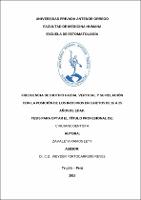| dc.contributor.advisor | Portocarrero Reyes, Weyder | |
| dc.contributor.author | Zavaleta Ramos, Lety | |
| dc.creator | Zavaleta Ramos, Lety | |
| dc.date.accessioned | 2019-07-23T20:44:33Z | |
| dc.date.available | 2019-07-23T20:44:33Z | |
| dc.date.issued | 2019 | |
| dc.identifier.uri | https://hdl.handle.net/20.500.12759/5198 | |
| dc.description.abstract | Determinar la frecuencia del biotipo facial vertical y su relación con la posición de los incisivos en sujetos de 16 a 25 años de edad.
Material y método: Este estudio, retrospectivo, transversal descriptivo y observacional. Se recolectaron un total de 145 análisis cefalométricos seleccionados de forma no probabilística por conveniencia los cuales fueron proporcionados por el centro radiográfico Digital Dent de la ciudad de Trujillo. El biotipo facial vertical se determinó a través del ángulo (Go-Gn a SN). Para determinar la posición de los incisivos se emplearon las medidas de la Inlcinación del Incisivo Inferior y superior, ángulo interincisal, posición del incisivo superior e inferior, ángulo del plano incisivo mandibular (IMPA) y el ángulo del plano mandibular. Para determinar la frecuencia del biotipo facial vertical y su relación con la posición de los incisivos en sujetos de 16 a 25 años de edad, se empleó el coeficiente de correlación de Spearman (Rho) con un nivel de significancia del 5%.
Resultados: Muestran que existe asociación estadísticamente significativa entre el biotipo facial vertical y la posición de los incisivos en sujetos de 16 a 25 años de edad. Asociándolo de acuerdo a la edad, se encontró que no existía asociación en los sujetos menores de 20 años edad por el contrario en el grupo etario de 20 años de edad a más si se encontró una asociación significativa. A si mismo nos muestra que si existe una mayor asociación con el sexo femenino, que con el sexo masculino.
Conclusión: Podemos concluir a mayor inclinación de los incisivos inferiores, mayor valor del ángulo GoGn – SN (patrón facial vertical). | es_PE |
| dc.description.abstract | To determine the frequency of the vertical facial biotype and its relation with the position of the incisors in subjects from 16 to 25 years of age.
Material and method: This retrospective, descriptive and observational cross-sectional study. A total of 145 selected cephalometric analyzes were collected in a non-probabilistic manner for convenience, which were provided by the Digital Dent radiographic center of the city of Trujillo. The vertical facial biotype was determined through the angle (Go-Gn to SN). To determine the position of the incisors, the Inferior and superior Incisor Inlculation measurements, interincisal angle, position of the upper and lower incisors, angle of the mandibular incisor plane (IMPA) and the angle of the mandibular plane were used. To determine the frequency of the vertical facial biotype and its relation with the position of the incisors in subjects of 16 to 25 years of age, the Spearman correlation coefficient (Rho) with a level of significance of 5% was used.
Results: They show that there is a statistically significant association between the vertical facial biotype and the position of the incisors in subjects from 16 to 25 years of age. Associating it according to age, it was found that there was no association in subjects under 20 years of age, on the other hand, in the age group of 20 years of age, if a significant association was found. To itself it shows us that if there is a greater association with the female sex, than with the male sex.
Conclusion: We can conclude at higher inclination of the lower incisors, greater value of the GoGn - SN angle (vertical facial pattern). | en_US |
| dc.description.uri | Tesis | es_PE |
| dc.format | application/pdf | es_PE |
| dc.language.iso | spa | es_PE |
| dc.publisher | Universidad Privada Antenor Orrego | es_PE |
| dc.relation.ispartofseries | T_ESTO_594 | |
| dc.rights | info:eu-repo/semantics/openAccess | es_PE |
| dc.rights.uri | https://creativecommons.org/licenses/by/4.0/ | es_PE |
| dc.source | Universidad Privada Antenor Orrego | es_PE |
| dc.source | Repositorio Institucional - UPAO | es_PE |
| dc.subject | Incisivos | es_PE |
| dc.subject | Biotipo facial vertical | es_PE |
| dc.title | Frecuencia de biotipo facial vertical y su relación con la posición de los incisivos en sujetos de 16 a 25 años de edad | es_PE |
| dc.type | info:eu-repo/semantics/bachelorThesis | es_PE |
| thesis.degree.level | Título Profesional | es_PE |
| thesis.degree.grantor | Universidad Privada Antenor Orrego. Facultad de Medicina Humana | es_PE |
| thesis.degree.name | Cirujano Dentista | es_PE |
| thesis.degree.discipline | Estomatología | es_PE |
| dc.subject.ocde | https://purl.org/pe-repo/ocde/ford#3.02.14 | es_PE |
| renati.type | https://purl.org/pe-repo/renati/type#tesis | es_PE |
| renati.level | https://purl.org/pe-repo/renati/level#tituloProfesional | es_PE |
| renati.discipline | 911016 | es_PE |
| dc.publisher.country | PE | es_PE |


